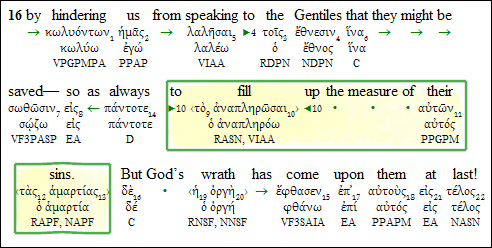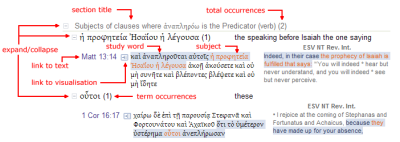This is the second part of the fourth post in my on-going series on the Bible Word Study report.
This post will look a little further into the Grammatical Relationships section. Our previous foray into the Grammatical Relationships section is here.
To refresh our collective memories, we’re looking at 1Th 2.16. Here it is in the reverse interlinear, with the phrase in question marked up using new Visual Markup features.
We left off the last post by saying:
So ἀναπληρόω means something like “make complete” or “fulfill” or “replace”. We begin to understand the nuance of each of those senses by considering who or what is doing ἀναπληρόω, and to whom or to what ἀναπληρόω is being done. Grammatical Relationships does all of the heavy lifting for you in searching out these usages, categorizing them, and returning them to us grouped by usage context.
So let’s examine the results and see what we can learn about the word ἀναπληρόω.
We’ll go through the hits in order, which means we’ll start with the section titled “Subjects of clauses where ????????? is the Predicator (verb)”. Recall that this means our study word, ?????????, is the verb of the clause. This section lists unique subjects of clauses that have ????????? as the verb.
Let’s look at the parts of the section. Feel free to click on the graphic to open a larger version in a separate browser window.
There are several pieces that need to be further explained. These include:
- section title:This was discussed in our previous post. It describes the contents of the section. Remember, if you stop your mouse cursor over the section title an expanded definition of the section will pop up.
- total occurrences:This number informs us of the total number of times the grammatical relationship has been located in the text.
- expand/collapse:The expand/collapse indicators occur all over the place in the Bible Word Study report. If you see a plus (+) and click on it, the section will expand. If you see a minus (-) and click on it, the section will collapse.
- study word:This isn’t actually a section or actively highlighted, I just thought I’d point it out to remind us what we’re looking for.
- subject:This text is the same as the subject listed in the previous heading. Here it is highlighted in context. Note that the darker background highlighting indicates the clause in which this subject occurs.
- link to text:If you click on the reference, you will go to the verse in the underlying text and see its full context. In this case, the text is the OpenText.org Syntactically Annotated Greek New Testament. Alternately, you can hover the reference and see the verse in a popup.
- link to visualisation:This icon links to the clause visualisation associated with the syntax database that the query uses. Here it is the OpenText.org Syntactically Annotated Greek New Testament: Clause Analysis.
- term occurrence:This number reflects the hits contained in the subsection. Each of the instances in the current example only occur once.
What do these two hits in this section tell us regarding the use of the word ?????????? They tell us that there are, according to the OpenText.org SAGNT, two instances of explicitly named subjects where the verb is ?????????. Those subjects are “the prophecy of Isaiah” (Mt 13.14) and “they”, referring back to “Stephanas and Fortunatus and Achaicus” (1Co 16.17).
So, we know that ????????? is used to describe how “the prophecy of Isaiah” comes to pass, or “is fulfilled” in Mt 13.14. We see a different sense of ????????? in 1Co 16.17, where Stephanas, Fortunatus and Achaicus “make full” or “make up for” the absence of the Corinthians from Paul. We also can see that our current instance, in 1Th 2.16, has no explicit subject stated.
The Grammatical Relationships also provides a section on “Complements (objects) of clauses where ????????? is the Predicator (verb)”. These instances involve the sorts of things that ????????? acts upon in the New Testament. There are six hits, as shown below:
Since we’re (ostensibly) looking into 1Th 2.16, let’s look at the complement (object) for that instance:
Here we see that “their sins” is the complement, thus they are what is being filled/fulfilled. Other instances appear different. We have an instance from Ga 6.2, “and so fulfill the law of Christ“. And we also have 1Co 14.16, where ????????? in the participle form, as predicator, takes as complement “the position of an outsider”. Perhaps the sense of ????????? is a bit different when it is used as a substantive participle?
We won’t go further here, but what we hope you can begin to see is that the Grammatical Relationships section of the Bible Word Study report assists not only in concording words but also helps in arranging the results based on grammatical relationships (informed by syntax). So one can work through not only instances of the word in question but also in the various syntactic relationships in which it is used.
Making this specific for ?????????: While working through the lexical definitions of the word is important (and done in the KeyLinks section) it can also be highly useful to see how the study word functions. So we know that ????????? means, roughly, to make complete or to fill or even fulfill. That’s great. But what sorts of things are ?????????‘d? What sorts of things are filled or made complete?
The next step, then, is to carefully work through passages where things are “filled” in similar ways to the study passage as this could provide insight for the use of ????????? in the study passage. Using Grammatical Relationships in the Bible Word Study report does a lot of the background in locating and grouping instances by syntactic context. It provides a starting point for you to work up from the word level (definition) to the phrase/clause level (syntactic relationships).
And it can be done in the original language (Greek or Hebrew) with parallel English phenomenon similiarly highlighted, if so desired (your Syntax Search preferences are mirrored in Grammatical Relationships). This makes it easy to review hits to examine further.
So we’ve examined the word in a context-free manner using KeyLinks. We’ve examined the word in a context-sensitive manner (syntactic context) using Grammatical Relationships. Hopefully your understanding of ????????? both generally and in the specific context of 1Th 2.16 is growing.
Next up: studying the word by examining how it is translated in a particular translation.








